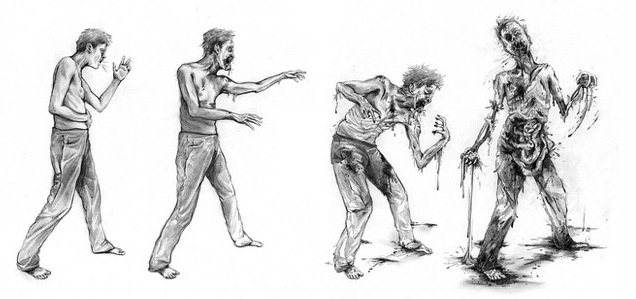An Actual Medical Journal Covered Three Cases of “Actual” Zombies in 1997
Braaaaiiiinnnnns

A British medical journal — that’s an actual, real, legitimate medical journal for scientists, academics, and their peers — published a study in 1997 on three cases of “real” zombification that were reported to have taken place in Haiti. And if you were wondering whether or not these were some kind of hoax, well, we wouldn’t go quite that far. But now we might start wondering how many actual diseases can be mistaken for zombification, and how many innocent, ill people are going to end up with their heads chopped off. JUST IN CASE.
In what could have been taken right out of Steven Schlozman‘s The Zombie Autopsies, The Lancet describes three young Haitians, identified by initials only, who had been displaying symptoms that have only ever been ascribed to people who have become zombies. The study, entitled “Clinical findings in three cases of zombification,” begins by stating that the United Nations has been concerned with zombification for quite some time, compares it to AIDS, and says that the act of turning someone into a zombie using “vodu” is classified as a crime under the Haitian Penal Code (Article 246). Here is the text from the Haitian Penal Code, translated from French:
So, what we’ve learned so far: zombification is considered murder in Haiti.
On to the case studies! Here is the case of a woman identified as FI:
FI was around 30 years old when she died after a short febrile illness and was buried by her family the same day in the family tomb next to her house. 3 years later she was recognised by a friend wandering near the village; her mother confirmed her identity by a facial mark, as did her 7-year-old daughter, her siblings, other villagers, her husband, and the local priest. She appeared mute and unable to feed herself. Her parents accused her husband of zombifying her (he was jealous of her after she had had an affair). After a local court authorised the opening of her tomb, which was full of stones, her parents were undecided whether to take her home and she was admitted to the psychiatric hospital in Port-au Prince […]
She was later diagnosed with catatonic schizophrenia. On to the next case, a young man named WD:
WD, 26 years old, was the eldest son of an alleged former tonton macoute (secret policeman) under the Duvaliers’ regime. The father was our principal informant together with WD’s mother and other villagers. When he was 18, he suddenly became ill with a fever, “his eyes turned yellow,” he “smelled bad like death,” and “his body swelled up”. Suspecting sorcery, his father asked his older brother to obtain advice from a boko [or sorcerer], but WD died after 3 days and was buried in a tomb on family land next to the house of a female cousin. The tomb was not, as was customary, watched that night. 19 months later, WD reappeared at a nearby cock fight, recognised his father, and accused his uncle of zombifying him […]
WD was later diagnosed with epilepsy and “organic brain syndrome.” Finally, MM:
MM, aged 31, was the younger sister of our principal informant who described her as formerly a friendly but quiet and shy girl, not very bright. At the age of 18, MM had joined some friends in prayers for a neighbour who had been zombified; she herself then became ill with diarrhoea and fever, her body swelled up and she died in a few days. The family suspected revenge sorcery. After 13 years, MM had reappeared in the town market 2 months before we met her, with an account of having been kept as a zombi in a village 100 miles to the north, and having borne a child to another zombi (or perhaps to the boko). On the death of the boko, his son had released her and she travelled home on foot.
It was posited that MM was living with fetal alcohol syndrome. However, the latter two “zombies” may have been misidentified completely, at least according to DNA tests. What is even more startling about these three people who were presumed to be zombies is that no one tried to kill them. The study specifically states that both FI and MM were “identified” and “kept,” respectively, as zombies, and WD identified himself as a zombie. And still — all three were in possession of their heads at the time of the study.
The conclusion states that people mistaken for zombies are just suffering from undiagnosed mental illnesses and other disabilities. But when there is voodoo at hand, it’s just easier to blame someone else for committing evil sorcery.
You can read the study in its entirety here.
(via io9)
Have a tip we should know? tips@themarysue.com